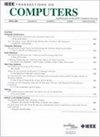HGNAS: Hardware-Aware Graph Neural Architecture Search for Edge Devices
IF 3.6
2区 计算机科学
Q2 COMPUTER SCIENCE, HARDWARE & ARCHITECTURE
引用次数: 0
Abstract
Graph Neural Networks (GNNs) are becoming increasingly popular for graph-based learning tasks such as point cloud processing due to their state-of-the-art (SOTA) performance. Nevertheless, the research community has primarily focused on improving model expressiveness, lacking consideration of how to design efficient GNN models for edge scenarios with real-time requirements and limited resources. Examining existing GNN models reveals varied execution across platforms and frequent Out-Of-Memory (OOM) problems, highlighting the need for hardware-aware GNN design. To address this challenge, this work proposes a novel hardware-aware graph neural architecture search framework tailored for resource constraint edge devices, namely HGNAS. To achieve hardware awareness, HGNAS integrates an efficient GNN hardware performance predictor that evaluates the latency and peak memory usage of GNNs in milliseconds. Meanwhile, we study GNN memory usage during inference and offer a peak memory estimation method, enhancing the robustness of architecture evaluations when combined with predictor outcomes. Furthermore, HGNAS constructs a fine-grained design space to enable the exploration of extreme performance architectures by decoupling the GNN paradigm. In addition, the multi-stage hierarchical search strategy is leveraged to facilitate the navigation of huge candidates, which can reduce the single search time to a few GPU hours. To the best of our knowledge, HGNAS is the first automated GNN design framework for edge devices, and also the first work to achieve hardware awareness of GNNs across different platforms. Extensive experiments across various applications and edge devices have proven the superiority of HGNAS. It can achieve up to aHGNAS:面向边缘设备的硬件感知图神经架构搜索
图神经网络(GNN)因其最先进的(SOTA)性能,在基于图的学习任务(如点云处理)中越来越受欢迎。然而,研究界主要关注的是提高模型的表达能力,而没有考虑如何为具有实时性要求和资源有限的边缘场景设计高效的 GNN 模型。对现有 GNN 模型的研究表明,不同平台的执行情况各不相同,经常出现内存不足(OOM)问题,这凸显了硬件感知 GNN 设计的必要性。为应对这一挑战,本研究提出了一种为资源受限的边缘设备量身定制的新型硬件感知图神经架构搜索框架,即 HGNAS。为实现硬件感知,HGNAS 集成了高效的 GNN 硬件性能预测器,能以毫秒为单位评估 GNN 的延迟和内存使用峰值。同时,我们研究了 GNN 在推理过程中的内存使用情况,并提供了一种峰值内存估算方法,在与预测器结果相结合时增强了架构评估的鲁棒性。此外,HGNAS 还构建了一个细粒度设计空间,通过解耦 GNN 范式,探索极限性能架构。此外,HGNAS 还利用多级分层搜索策略,方便浏览庞大的候选方案,从而将单次搜索时间缩短到几个 GPU 小时。据我们所知,HGNAS 是首个面向边缘设备的自动 GNN 设计框架,也是首个实现跨不同平台 GNN 硬件感知的工作。跨各种应用和边缘设备的广泛实验证明了 HGNAS 的优越性。与 ModelNet40 上的 DGCNN 相比,HGNAS 的速度提高了 10.6 美元,内存峰值减少了 82.5%,精度损失几乎可以忽略不计。
本文章由计算机程序翻译,如有差异,请以英文原文为准。
求助全文
约1分钟内获得全文
求助全文
来源期刊

IEEE Transactions on Computers
工程技术-工程:电子与电气
CiteScore
6.60
自引率
5.40%
发文量
199
审稿时长
6.0 months
期刊介绍:
The IEEE Transactions on Computers is a monthly publication with a wide distribution to researchers, developers, technical managers, and educators in the computer field. It publishes papers on research in areas of current interest to the readers. These areas include, but are not limited to, the following: a) computer organizations and architectures; b) operating systems, software systems, and communication protocols; c) real-time systems and embedded systems; d) digital devices, computer components, and interconnection networks; e) specification, design, prototyping, and testing methods and tools; f) performance, fault tolerance, reliability, security, and testability; g) case studies and experimental and theoretical evaluations; and h) new and important applications and trends.
 求助内容:
求助内容: 应助结果提醒方式:
应助结果提醒方式:


